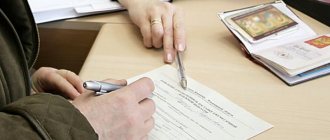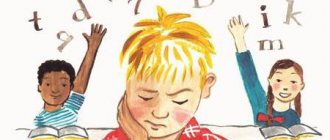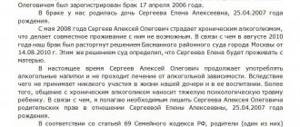Characteristics of a student under guardianship material (grade 3) on the topic
The guardian, _________________, conscientiously fulfills his parental responsibilities towards the child, knows what problems __________ have, and helps him correct them. She is an active assistant to the child in his studies. If any problems arise, __________ reacts immediately and tries to find methods to solve them. Attends parent meetings regularly. Favorable living conditions have been created for a full-fledged life for the child under care. The student is provided with everything necessary.
It is not always possible for ____________to generalize and draw independent conclusions and establish cause-and-effect relationships. Computational skills are well developed; mistakes are made, for the most part, due to inattention and lack of concentration. The reading speed corresponds to the norm, but the reading is monotonous and erroneous, and does not delve into what he is reading about. Speech is slurred. I have learned the multiplication table, but sometimes I make mistakes. Russian and English are more difficult. He writes dictations with grades of two. Spelling skills have not been developed.
Characteristics of emotional and moral standards of orphans
The fourth group includes children with a low level of development of social emotions. These children drew inanimate objects as good-evil standards. Also, children could draw the same picture, referring to both “good” and “evil”. These preschoolers do not differentiate emotions and have no understanding of social norms. Moreover, this group of children is the largest among orphans.
When analyzing projective drawings, attention was paid to the color scheme, which reveals the emotional attitude to what was drawn, and to the content of the drawing, which allows us to determine the state of formation of the social standard. In addition, the formation of emotional and moral standards was determined by the child’s adequate reflection of the content side of the social standard. Repeating standards were identified and grouped into the following groups: mother, close people, peers, animals, nature, fairy-tale characters, inanimate objects. At the same time, the typical standards of “good and evil” of children from the family differed from the drawings of orphans. The frequency characteristics of the use of standards for the two studied groups of children were also quite different.
Characteristics of guardianship of a child from school: samples for elementary and high school students
- date the child entered school;
- the general level of knowledge at the beginning of studies and the acquired skills at the time of writing the characteristics, which subjects are more successfully mastered, what are the difficulties;
- features of thought processes, memory, attentiveness;
- level of health and physical activity;
- psychological adaptation in a team, relationships with peers, teachers;
- student motivation to study.
Title: “Characteristics of a student” - a selection of psychological and pedagogical characteristics (more than 50 pieces), as well as instructions and recommendations for writing your own characteristics. Year of publication: 2009 - 12 Format: doc to rar. archive Number of pages: many Size: 5.2 MB Quality: good
This description was compiled on behalf of the class teacher for a 7th grade student. This characteristic represents a “good guy”. He is an active, initiative student who has some negative qualities (excessive talkativeness in class, periodic harshness in behavior and communication).
I bring to your attention four characteristics for students in grades 1-4. The material contains characteristics for a lagging student, a student from a disadvantaged family, a supervised child and a successful student. The characteristics were written for presentation to the PMPC, for submission to the court and to the PDN commission.
Characteristics for Orphans and Children Sample
Unlike a resume, a reference to the guardianship authorities is written not by the student himself, but by his teacher on an A4 sheet of paper or the letterhead of the educational institution. Signed by the class teacher and school director. This document must remain in the child’s personal file and a similar version is additionally written to social authorities as necessary, where it is certified by specialists.
We recommend reading: Should You Take a Russian Passport with You to Turkey?
1 answer. Moscow Viewed 91 times. Asked 2011-11-18 09:10:47 +0400 in the topic “Family Law” The role of guardianship and trusteeship authorities in the deprivation of parental rights - The role of guardianship and trusteeship authorities in the deprivation of parental rights. more 1 answer. Moscow Viewed 322 times. Asked 2011-11-22 13:42:24 +0400 in the subject “Family Law”
Examples of characteristics for a supervised elementary school student
Characteristics of a 1st grade student at secondary school No. 76 Ivan Khoroshavin Ivan Khoroshavin, born June 20, 2010, lives: Novosibirsk, st. Green, 3/2-12. in the guardian's family. He has been studying at school since 09/01/2017. Ivan enjoys learning, has a high degree of efficiency, and is active during classes. Prepares homework independently. The ease of perception of information and the fast pace of preparing tasks somewhat interfere with the formation of diligence, which does not affect the learning results. The boy is independent and neat. He carefully puts his things in his backpack, checking that they are complete. Dressed cleanly, according to the season, neat. Does not allow violations of discipline during lessons or breaks. He is modest and cannot always fight back against offenders. Tries to avoid potentially dangerous situations. He is not registered with the KDN. Doesn't skip classes. He has many friends and is drawn to high school kids. Welcoming, friendly. Ivan Kolosov’s guardian Olga Andreevna attends parent meetings in full and actively asks questions. Worried about the child, he regularly calls the class teacher. She brought potted flowers to decorate the classroom. The boy happily runs towards O.A. Kolosova when she picks him up from school. It is obvious that a trusting relationship has developed between the guardian and Ivan. School director _________________________S.P. Tolkova Class teacher: ___________________G.Kh Semenova
CHARACTERISTICS of a 5th grade student at secondary school No. 76 Semenova Semen Semenov S. Born 09/15/2016, lives Novosibirsk, Frunze Ave., 119-3. Parents are deprived of parental rights. The boy and his younger brother Roman (2 years old) are under the care of his own aunt Rodimina Asya Trofimovna. The boy is physically well developed and is involved in the swimming section. Has a congenital disease of the respiratory system (asthma). Semyon strives to gain knowledge and excellent grades. Stable in all disciplines. Incredible performance allowed me to finish the second half of the year with “5” grades in all subjects. A good analyst immediately identifies the main idea from the proposed material. During the period of care (three years), positive changes in learning and behavior are obvious. Assiduous, diligent. Semyon works independently, with the support of teachers, to develop his character. Trying to get rid of low self-esteem and increased anxiety. He is friendly and friendly with his classmates. Took charge of the 2nd grade children under his care. Very affectionate, grateful for the good attitude. She studies in a theater group at the Palace of Youth Creativity. He is interested in literature. The relationship with my aunt is smooth and obedient. School director _________________________S.P. Tolkova Class teacher: ___________________G.Kh Semenova
- Does the child have a desire to learn or is it reduced?
- How often does the student miss classes, are there any failures in certification work.
- The worldview of a minor and his beliefs.
- How successfully does the student complete his homework, and if not, then for what reason.
- Did teachers and the school psychologist try to correct the situation in any way, and if so, by what methods?
- How critical is the situation?
- Is there a need for intervention from any services or departments, including security forces?
- Psychological climate in the family. What problems do foster parents face and how do they solve them?
- Negative episodes from the child’s life that could affect his studies.
- The reason for poor studies: the child is pedagogically neglected;
- he has pathologies of intellectual development of a biological nature.
- just doesn't want to study;
You may like => When appealing, all levels have been passed
Information about the company/employer
Characteristics are issued only to those persons who requested it. In this case, it may be the candidate for adoptive parents, guardianship authorities or the court. It is drawn up in two copies, one of which is given to the applicant, the other remains with the organization.
More to read —> Okof Ladder Transformer
Even though the list of documents is quite lengthy, you should not neglect the job description. It may turn out that this particular paper will play a key role in the court making a decision in favor of the adoptive parent.
The last criterion will be the physiological state. The teacher must monitor the child. If he notices bruises and abrasions on the body of a preschooler, he must mention this in the description. It is not necessary that the father and mother are to blame, but their non-participation in upbringing, leading to damage, is also a reason for the revocation of parental rights.
A characteristic that contains, in addition to basic information about the child’s development, information about the non-participation in the upbringing of mother and father or both parents at once will have a significant impact on employees of the educational institution. The teacher must also mention who picks up and brings the child. It would be useful to give an example of a conversation with a local doctor. The specialist will be able to tell you how often the baby gets sick and whether treatment recommendations are followed.
Role in the process of transferring the baby to guardianship authorities
Characteristics of a child from kindergarten to the guardianship authorities are needed to monitor his development. PLO staff will be able to assess the work of educators and the need to provide guardianship. If obvious deviations are identified, certain adjustments will be made. The child may be transferred to another preschool educational institution (DOU) or advised to undergo a course of treatment from a psychologist or speech therapist. If the reason is the parents’ dishonest attitude towards their duty to raise the child, then representatives of the PLO will conduct an examination of the living conditions. The father and mother will be warned about possible consequences, including deprivation or restriction of parental rights. The general list of situations requiring such a characteristic is as follows:
An important point is that the characteristics should reflect only reliable and up-to-date information. If the company's management writes down false information, then it is worth considering that the person who compiled the document bears personal responsibility.
- information about the employee, including his last name and initials, date of birth;
- the position occupied by the specified citizen;
- the basis for appointment to the position, expressed in a specific order, in particular, the specific details of the document are indicated;
- the period during which the person works for the company;
- responsibilities assigned to a citizen by job description.
More to read —> Standard Thermal Energy Per Square Meter of Living Space
How does the characteristic influence the decision?
Responsibilities for drawing up the act in question are assigned to employees of the personnel department of the company where the person works. In a situation where the company has a small staff and there is no HR department, the manager himself or his secretary can take care of drawing up the paper. In addition, this may be any other responsible person. There is a requirement that the act be signed by the management team of the company and also stamped.
The Federal Law fully regulates the conditions under which a person can receive guardianship. In accordance with established acts, the following categories of people can become a guardian:
Sample characteristics for a supervised student (from the experience of a social teacher)
Child's name
has been studying at this school since 20__. During her studies, she showed herself to be a student with weak abilities. Learning motivation is positive. He has “satisfactory” grades in all subjects. Based on the results of the 20__-20__ academic year, she was conditionally transferred to grade No. with an “unsatisfactory” grade in mathematics. At the beginning of the academic year, academic debt was successfully repaid.
The motivation for educational activities aimed at obtaining new knowledge is weakly expressed. The existing intellectual abilities are not fully realized due to the systematic lack of parental control. Does not complete homework or does not complete it in full. There are absences from classes for no valid reason, and frequent tardiness. There are also cases when the child did not spend the night at home.
Characteristics of emotional and moral standards of orphans
For the majority of kindergarten children (57.5%), “the kindest things” are associated with their loved ones. Orphans depict “Good” in a detached manner, mostly drawings of inanimate objects (45%) and nature. Thus, the data obtained clearly indicate that orphans generally do not classify people as “good”; orphanage pupils more often associate people with evil, which means that their emotional and moral standards are deformed.
The absence or deviant care of a significant adult reduces the child’s ability to internalize. The social “situation of development” turns into a “situation of impossibility” for the child, contributing to the emergence of general tension in him and the development of severe affective states against this background. The emotional influence of the child’s environment has a decisive impact on his physical, mental and intellectual development [3]. Positive emotional contact contributes to faster and better assimilation of complex moral norms, principles of social life, and rules.
How to write a reference for a supervised child from the class teacher
- performance (with high performance, the student can actively participate in classes in all lessons, with average fatigue is observed, in case of poor performance, he suffers from irritability, drowsiness, lethargy);
- the ability to highlight the main thing in the studied material;
- to what extent he thinks independently;
- ability to work in classes at the required pace;
- manifestation of self-control in the educational process;
- How consciously the child approaches learning activities.
- how efficient the student is;
- does he willingly carry out the teacher’s tasks;
- are there any deviations in behavior that need correction;
- whether the child easily perceives information, how he copes with homework;
- the level of independence is described;
- whether he is registered with the KDNiZP, the department of precinct commissioners;
- the child’s relationships in the team, whether he has friends;
- what is the condition of his clothes, shoes, stationery;
- how the guardian performs his duties, what are the relationships in the family.
Characteristics of an orphan child in a general education institution
The atmosphere in the family is non-conflict, but the relationship is not trusting enough, the level of mutual understanding with the grandmother is low, the guardian strictly controls her behavior and limits her independence. The relationship between the class teacher and the guardian can be described as neutral.
Study: The teenager is not focused on cognitive activity and does poorly in subjects. The level of training is low. There are disturbances of attention, low levels of concentration and distribution. During lessons he is distracted by external stimuli. When performing educational tasks, he is not able to switch from one type of activity to another, cannot plan his activities, or correct a mistake if it is pointed out. It takes time to develop. Due to errors, he does not always fully understand the text he reads; he retells it on his own. Logical thinking is poorly developed; it cannot draw basic conclusions or solve logical examples. Vocabulary does not meet age standards. He makes sloppy entries in notebooks and writes with many errors. In mathematics, he performs computational operations slowly, with a large number of errors, and does not always understand the meaning of the problem. In educational activities, a teenager needs organizing, planning help and approval at all stages of the lesson.
Pedagogical characteristics for a student under guardianship
The girl does not have enough knowledge about the world around her. Knows information about himself. Experiences difficulties in establishing simple cause-and-effect relationships between phenomena of reality. Mental operations are insufficiently developed. In mathematics: counting within 10 mechanical. Learned to solve examples of addition and subtraction within 4 using auxiliary tools. With the help of formulates a solution to a problem in one action. Uses to compare adjacent numbers within 4. Knows the composition of numbers within 4.
Emotional, lively, sociable, disciplined, lately she has been reacting aggressively to teachers’ comments and not fulfilling their demands. Has many friends among his peers. A developed sense of collectivism, camaraderie, a sense of duty, and decency. A case of alcohol consumption was noticed (according to the parents). The girl maintains relationships with older boys.
Characteristics of an orphanage pupil from a teacher
The child can understand the main idea of a fairy tale, a picture, combine several pictures based on a common feature, sort pictures into groups based on an essential feature, but is not well oriented in space and time. Characteristics of a child, sample
The document drawn up by the teacher, describing the level and degree of personal development, must indicate the child’s performance, reaction to comments and demands, ability to manage his behavior, character traits (modest, quiet, impulsive, etc.). The description of the personality of a preschooler should also reflect the state of psychophysical processes: attention (stable or not), ability to concentrate, switchability, perception of phenomena (appropriate or not for age), the child’s time representations, development of memory and verbal-logical thinking. The characteristics of the child in the preschool educational institution from the teacher must be dated. The teacher's signature is placed on the last page. The document is endorsed by the head of the preschool educational institution.
The mother, due to her individual personal abilities and state of health, is able to satisfy only the minimum necessary needs to maintain the life activity and upbringing of the minor. An emotionally significant and attractive person for the child is her aunt (mother’s sister), with whom the minor maintains a positive relationship, however, due to their separate residence and only periodic contact, they do not fully satisfy the needs that were not satisfied in turn by the parents. Educational psychologist _____________ UO
The social shelter is allocated special premises in accordance with the established procedure, which must be sufficient in area, aesthetic, have all types of communal amenities (central heating, water supply, sewerage, electric lighting, radio, telephone), meet sanitary and hygienic standards, fire safety requirements and be equipped with the necessary rigid and soft goods, other material supplies and equipment. Preschool educational institutions employees who make up the profile must adhere to the standards of the educational program adopted in their institution. Such a requirement will help assess the degree to which the preschooler has mastered the material and see a list of goals he has achieved.
Loves to be in kindergarten. A sample of writing a psychological and pedagogical profile for a child. Psycho-pedagogical characteristics. When entering a kindergarten, any educational institution, or to provide information about a specific person to government agencies, a character reference for a kindergarten child may be required. The drafting template may change. Psychological characteristics of the child f. attending kindergarten from 2011 Alicia is brought and picked up from kindergarten mainly by her mother, sometimes together with her father.
To pass the PMPK or ITU commission, a pedagogical characteristic for a child is required. It can be written on specific points or in any form. I offer a sample of my characteristics of a child aged 3.5 years, which was attached to the documents for passing the MSE to determine the status of a disabled child. The description was written in free form and was completely appropriate. It must also be certified by the seal of the kindergarten and necessarily the signatures of the teacher and the head.
We recommend reading: Mortgage rate reduction at Sberbank in 2021 for young families
During my studies in kindergarten, my active vocabulary increased. Free expressions are dominated by simple, common, complex sentences. There is insufficient development of the grammatical forms of the language (errors in coordination and control)
. Retells coherently, consistently, does not violate semantic parts. Sound pronunciation is at the stage of production and automation of sounds. There are positive dynamics in the learning process.
The child does not immediately show trust in others; negative reactions to requests from adults, stubbornness, and whims are observed. Contacts with peers are short-lived, creates conflict situations during games (takes away and throws toys, pushes children). The games are monotonous, he quickly loses interest in the game, moves from one toy to another.
Educator: Ivanova M.I. Characteristics of a pupil of the state educational institution for children - orphans and children left without parental care "Krasnokamensk orphanage" Full name and date of birth of the child Mother: Father: The girl arrived at the Krasnokamensk orphanage on 01/01/2008 from the orphanage in the city of Krasnokamensk "Solnyshko" previously lived in village of Soktuy-Milozan. Currently, the girl is studying in 9th grade at secondary school No. 10.
Constant monitoring of appearance, cleanliness of clothes, hands, and hairstyle is required. Relationships with classmates are complicated, he often gets angry, freaks out, can tear a book, scatter it, chew a pencil, cannot critically evaluate his actions, there is no adequate understanding of what is good and what is bad. He cannot and does not want to play in a team, creating conflict situations.
Characteristics of a supervised child from the class teacher
The volume and content of the characteristics, which present basic data about the status and school success of the child, are primarily determined by the goals that determine the preparation of such a document. For a student who has lost his or her parents and is in the care of grandparents or other relatives, documentation is prepared on a scheduled basis annually, as part of crime prevention efforts. If improper care for a child under guardianship is detected, the class teacher promptly draws up an additional reference based on the sample, which is submitted to the social security authorities and used in cases of partial or complete deprivation of guardianship rights.
The profile for a primary school student under guardianship does not provide for a psychological and pedagogical analysis of the individual: representatives of the guardianship authorities only need to obtain data on academic performance and the characteristics of family relationships in order to decide whether the right to guardianship of a minor can be reserved for the family or whether the child requires state support.
- motivation for learning, getting an education - strong or weak;
- core and elective subjects with high academic performance;
- core and elective subjects with low performance;
- items of interest
- subjects in which there is a complete lack of interest;
- extracurricular interests;
- stubbornness or flexibility;
- perseverance or restlessness;
- influence or suspiciousness;
- friendliness or isolation;
- restraint or spontaneity;
- organizational skills – strong or weak;
- leadership or followership;
- responsiveness or indifference;
- shyness or boldness;
- respect or insolence;
- independence or need for support, constant control, guidance;
- trusting or hostile relationships in the family;
- aggressiveness or calmness;
- “difficult” or pliable, affectionate disposition;
- high or low self-esteem;
- ambition or modesty;
- satisfied or painful need for acceptance, support, attention from adults and peers;
- close or tense relationships with mother and father, guardian or trustee, relatives.
- Title: “Characteristics...”;
- Full name, date of birth, school number and class the child attends,
- place of residence;
- character traits;
- degree of academic performance in core and elective subjects;
- extracurricular interests and additional activities (clubs, sections);
- behavior;
- relationships with peers;
- features of family relationships (cohabitation or separation with mother or father, presence of brothers or sisters, appointment of guardianship or trusteeship);
- the presence or absence of basic things (seasonal clothing and shoes, school supplies), the degree of satisfaction of basic needs (safety, food, warmth, sleep, cleanliness);
- date of;
- signatures.
You may like => I am a pensioner They send me Apartment Tax Receipts
Sample characteristics of an orphan for adoption
For example, the following data were presented in the media: in 2007, more than six thousand orphans were returned to Russian orphanages [3]. Returning a child to an orphanage means secondary orphanhood and entails a number of negative consequences for him - distrust of all adults, aggravation of his psychological problems. The presence of frequent abandonment of adopted children discredits the entire system of state social support for orphans as a whole. It should be noted that the problem of returning adopted children is relevant not only for Russian society, but also for economically more developed countries.
We recommend reading: What Specific Rights Mean
A foster family is one of the forms of placement in raising orphans and children left without parental care. It is formed on the basis of an agreement on the transfer of a child (children) to be raised in a family and an employment contract. The guardianship and trusteeship authority determines the number of children who can be placed in a given foster family, the order and timing of their transfer, and the duration of the child’s adaptation period in the foster family. For the foster parent, the time spent working is included in the work experience.
Psychological and pedagogical characteristics of a student under guardianship, a ready-made example
(Child's name) came to first grade in September 2012. Social adaptation in the class was difficult, communication with children was not easy, the boy was quite complex and avoided active participation in any event (it doesn’t matter whether it was a social assignment or a game).
A package of documents named in the law for presentation to the guardianship and trusteeship authorities will show the formal characteristics of a person. The characteristics will give an understanding of moral, ethical and personal qualities. It is obvious that the majority of citizens are not drug addicts or have previous convictions. But is everyone capable of taking responsibility for the fate of another person?
The school psychologist conducted a diagnosis of intra-family relationships, which gave the following results: the child’s subjective assessment of his family is positive, the child feels more trust in his mother, the relationship with his father is complex. The reason is that the boy’s father is not his own. The presence of negative feelings towards this person is clearly visible in the boy’s conversations and drawings - the child deliberately excluded him from his own inner world. He has not yet determined his place in the family; he is passive and quiet in all relationships with all family members.
The girl treats teachers and adults politely and respectfully. He makes contact quickly, loves communication and trusting relationships. She has many friends in her class and school. He tries to take an active part in the life of the class and expresses a desire to carry out complex assignments conscientiously.
Characteristics of the child to the guardianship authorities from school, kindergarten
It must be submitted to the guardianship and trusteeship authority. This is an important document on the basis of which the final verdict of this service is made. After all, government officials need to make sure that the person meets all the criteria that apply to candidates.
Only a person who spends a long time with a minor during the day can provide the above information with a high level of reliability. For example, a class teacher at a school, a circle leader, a school psychologist or a social worker who has been observing the student’s behavior for a long time.
Characteristics of a supervised child from the class teacher sample
He is being brought up in the family of his grandmother Natalya Nikolaevna Vasilyeva, the guardians take good care of Danil’s studies and appearance, regularly call the class teacher to find out his progress or warn about illness, worry about the child, take an active part in the life of the class and the renovation of the classroom.
Does not violate school rules. Outwardly neat, he always goes to classes in a school uniform. Absences from classes are only for a valid reason. He is often an assistant to the class teacher in organizing the class team, and treats everything with humor and kindness. Fulfills teachers' demands and instructions responsibly, understands criticism, and agrees with it. Skills of cultural behavior have been developed, behavior is always conscious.
17 Apr 2021 polrostov 293
Share this post
- Related Posts
- Federal Law 138 Promotion of Housing Development Amendments to the Law Signed 03/01/2021 Construction Read
- Wiretapping Apartments by Neighbors
- Vsk Insurance For Injury
- Speech of a Lawyer According to a Special Order Sample
EXAMPLES OF CHARACTERISTICS
The girl is very sociable, emotional, inquisitive, and in classes she is active and eager to learn something new. He calmly makes contact with both peers and adults, knows the rules of communication, knows how to manage his behavior, knows what is possible and what is not.
XXXXXXXXX Daria
Learning ability.
Ksyusha is absent-minded, inattentive, and withdrawn.
Often not in the mood. There are problems with mastering educational material. There is no contact with teachers, there is no concentration in classes, the child gets tired quickly. Does not observe discipline, does not always fulfill the tasks and requests of the teacher. She does not carry out public assignments the first time; she needs to explain several times what is required of her. The type of thinking is visual - effective. May 19, 2021 uristgd 102
Share this post
- Related Posts
- What date does discounted train travel in St. Petersburg begin for pensioners in 2021?
- OKVED for retail trade of pharmaceutical and medical goods
- Is Activation of a Transport Card Required After Topping up the Account?
- Transport tax benefits for Chernobyl victims in Udmurtia 2021-2021
Sample characteristics from the place of work for child custody
When drawing up this document, you must adhere to certain rules. It should be noted right away that there is no generally established form of characteristic.
The paper from the place of work must contain the following data:
- detailed information about a specific applicant for adoptive parents. It is important to indicate his last name, first name and patronymic. Next you should write the date and place of birth. If the candidate is a representative of the stronger sex, then military service must be registered. For men and women, it is important to indicate marital status, education, awards, and so on;
- The next point is the provision of information about the work activities of a particular person. It is necessary to indicate the following information: when the person began performing his official duties, when he submitted his resignation. The last point is relevant only if the citizen no longer works in this organization. It is also necessary to describe what career heights he managed to achieve. Among other things, emphasis should be placed on the person’s professional skills. It is important to list the places where he studied and improved his qualifications. You are required to report your work achievements in writing. Also in the description, it should be noted that the candidate for adoptive parents has all sorts of merits. We should not forget about disciplinary sanctions if they occurred during his work at a particular enterprise;
- the employee’s personality characteristics are the most important point of the entire document. Here you need to indicate information that reveals the personal qualities of a person. In the future, this section will determine whether the applicant will be entrusted with the guardianship of the child or not.
A sample reference from the place of work for child custody can be downloaded.
Dear readers! To solve your problem right now, get a free consultation
— contact the on-duty lawyer in the online chat on the right or call:
+7
— Moscow and region.
+7
— St. Petersburg and region.
8
- Other regions of the Russian Federation
You will not need to waste your time and nerves
- an experienced lawyer will take care of solving all your problems!
Mandatory subparagraphs
Like any other official document, the characteristic must be drawn up in accordance with the regulations, otherwise it will lose its legal weight.
Free legal consultation We will answer your question in 5 minutes!
Ask a Question
The characteristic consists of three parts. The first part contains the child’s personal data, namely:
- Child's full name.
- Educational institution and class in which the child studies.
- Date of birth and place of residence.
All this is written either in the upper right corner or in the center of the sheet.
The second part of the characteristics provides the following information:
- Date of admission of the child to the educational institution.
- Level of education upon admission and level of knowledge at the time of writing the characteristics. The most and least difficult subjects for a given child are indicated.
- Specificity of thinking, memory, concentration and perception of information.
- Level of social adaptation - roles accepted in the team, relationships with peers and teachers.
- Level of motivation for the educational process.
In the third part, the author of the characteristics draws up the main conclusions and forecasts, puts a date, full name and signature. Next is the name and signature of the school psychologist. Below is a sample.







